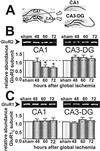Remodeling of alpha-amino-3-hydroxy-5-methyl-4-isoxazole-propionic acid receptor subunit composition in hippocampal neurons after global ischemia
- PMID: 11087875
- PMCID: PMC27229
- DOI: 10.1073/pnas.97.24.13360
Remodeling of alpha-amino-3-hydroxy-5-methyl-4-isoxazole-propionic acid receptor subunit composition in hippocampal neurons after global ischemia
Erratum in
- Proc Natl Acad Sci U S A 2001 Jan 30;98(3):1317. Optiz T [corrected to Opitz T]
Abstract
Transient global ischemia induces selective delayed cell death, primarily of principal neurons in the hippocampal CA1. However, the molecular mechanisms underlying ischemia-induced cell death are as yet unclear. The present study shows that global ischemia triggers a pronounced and cell-specific reduction in GluR2 [the subunit that limits Ca(2+) permeability of alpha-amino-3-hydroxy-5-methyl-4-isoxazole-propionic acid (AMPA) receptors] in vulnerable CA1 neurons, as evidenced by immunofluorescence of brain sections and Western blot analysis of microdissected hippocampal subfields. At 72 h after ischemia (a time before cell death), virtually all CA1 pyramidal neurons exhibited greatly reduced GluR2 immunolabeling throughout their somata and dendritic processes. GluR2 immunolabeling was unchanged in pyramidal cells of the CA3 and granule cells of the dentate gyrus, regions resistant to ischemia-induced damage. Immunolabeling of the AMPA receptor subunit GluR1 was unchanged in CA1, CA3, and dentate gyrus. Western analysis indicated that GluR2 subunit abundance was markedly reduced in CA1 at 60 and 72 h after the ischemic insult; GluR1 abundance was unchanged in all subfields at all times examined. These findings, together with the previous observation of enhanced AMPA-elicited Ca(2+) influx in postischemic CA1 neurons, show that functional GluR2-lacking, Ca(2+)-permeable AMPA receptors are expressed in vulnerable neurons before cell death. Thus, the present study provides an important link in the postulated causal chain between global ischemia and delayed death of CA1 pyramidal neurons.
Figures




Similar articles
-
Hypothermia rescues hippocampal CA1 neurons and attenuates down-regulation of the AMPA receptor GluR2 subunit after forebrain ischemia.Proc Natl Acad Sci U S A. 2003 Mar 4;100(5):2906-10. doi: 10.1073/pnas.2628027100. Epub 2003 Feb 26. Proc Natl Acad Sci U S A. 2003. PMID: 12606709 Free PMC article.
-
Selective reduction of GluR2 protein in adult hippocampal CA3 neurons following status epilepticus but prior to cell loss.Hippocampus. 1998;8(5):511-25. doi: 10.1002/(SICI)1098-1063(1998)8:5<511::AID-HIPO9>3.0.CO;2-W. Hippocampus. 1998. PMID: 9825961
-
Ischemia and ischemic tolerance induction differentially regulate protein expression of GluR1, GluR2, and AMPA receptor binding protein in the gerbil hippocampus: GluR2 (GluR-B) reduction does not predict neuronal death.Stroke. 2002 Apr;33(4):1093-100. doi: 10.1161/01.str.0000014205.05597.45. Stroke. 2002. PMID: 11935066
-
The AMPAR subunit GluR2: still front and center-stage.Brain Res. 2000 Dec 15;886(1-2):190-207. doi: 10.1016/s0006-8993(00)02951-6. Brain Res. 2000. PMID: 11119696 Review.
-
AMPA receptor subunit GluR2 gates injurious signals in ischemic stroke.Mol Neurobiol. 2005 Oct;32(2):145-55. doi: 10.1385/MN:32:2:145. Mol Neurobiol. 2005. PMID: 16215279 Review.
Cited by
-
Hypothermia rescues hippocampal CA1 neurons and attenuates down-regulation of the AMPA receptor GluR2 subunit after forebrain ischemia.Proc Natl Acad Sci U S A. 2003 Mar 4;100(5):2906-10. doi: 10.1073/pnas.2628027100. Epub 2003 Feb 26. Proc Natl Acad Sci U S A. 2003. PMID: 12606709 Free PMC article.
-
Aberrant formation of glutamate receptor complexes in hippocampal neurons of mice lacking the GluR2 AMPA receptor subunit.J Neurosci. 2003 Oct 15;23(28):9367-73. doi: 10.1523/JNEUROSCI.23-28-09367.2003. J Neurosci. 2003. PMID: 14561864 Free PMC article.
-
Resveratrol Preconditioning Protects Against Ischemia-Induced Synaptic Dysfunction and Cofilin Hyperactivation in the Mouse Hippocampal Slice.Neurotherapeutics. 2023 Jul;20(4):1177-1197. doi: 10.1007/s13311-023-01386-0. Epub 2023 May 19. Neurotherapeutics. 2023. PMID: 37208551 Free PMC article.
-
Estrogen protects against global ischemia-induced neuronal death and prevents activation of apoptotic signaling cascades in the hippocampal CA1.J Neurosci. 2002 Mar 15;22(6):2115-24. doi: 10.1523/JNEUROSCI.22-06-02115.2002. J Neurosci. 2002. PMID: 11896151 Free PMC article.
-
The protective effect of heat acclimation from hypoxic damage in the brain involves changes in the expression of glutamate receptors.Temperature (Austin). 2014 Jul 1;1(1):57-65. doi: 10.4161/temp.29719. eCollection 2014 Apr-Jun. Temperature (Austin). 2014. PMID: 27583282 Free PMC article.
References
-
- Choi D W. Trends Neurosci. 1995;18:58–60. - PubMed
-
- Pulsinelli W A, Brierley J B, Plum F. Ann Neurol. 1982;11:491–498. - PubMed
-
- Seeburg P H. Trends Neurosci. 1993;16:359–365. - PubMed
-
- Verdoorn T A, Burnashev N, Monyer H, Seeburg P H, Sakmann B. Science. 1991;252:1715–1718. - PubMed
-
- Geiger J R, Melcher T, Koh D S, Sakmann B, Seeburg P H, Jonas P, Monyer H. Neuron. 1995;15:193–204. - PubMed
Publication types
MeSH terms
Substances
Grants and funding
LinkOut - more resources
Full Text Sources
Medical
Miscellaneous

